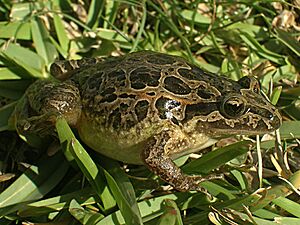Iberian painted frog facts for kids
Quick facts for kids Iberian painted frog |
|
|---|---|
 |
|
| Conservation status | |
| Scientific classification | |
 |
|
| Synonyms | |
|
Discoglossus hispanicus Lataste, 1879 |
The Iberian painted frog (Discoglossus galganoi) is a type of frog. It belongs to the Alytidae family. You can find this frog in Portugal and Spain. It lives in many different places. These include forests, bushy areas, and near rivers. It also likes swamps, marshes, and even sandy shores. Sometimes, it lives in farmland and grassy areas. Sadly, its home is shrinking, which is a problem for these frogs.
What Does it Look Like?
This frog is quite small. It has a wide head and a strong body. Most Iberian painted frogs have rows of small bumps, like warts, on their backs. However, some frogs do not have these bumps. Their eye pupils look like an "upside-down droplet."
These frogs come in three main colors. Some are a plain greyish-brown. Others have large dark spots with light edges. A third type has bright stripes on a dark background. These stripes run along its back and sides.
Where Does it Live?
The Iberian painted frog lives only in Spain and Portugal. This means it is endemic to these countries. It can be found high up in the mountains, almost 2,000 meters (about 6,400 feet) high.
Its favorite places to live are open areas and grassy fields. It also likes thick bushes and the edges of woodlands. You can often find it in swamps or small valleys. These frogs usually stay near water.
Life Cycle and Reproduction
The breeding season for these frogs usually starts in October. It can last until December. Female frogs can mate several times during this period. They can lay as many as 5,000 eggs in total. The eggs are laid in water. They can be laid one by one or in small groups. They are placed on the bottom or attached to plants.
The eggs hatch into tadpoles in about 2 to 6 days. This depends on how warm the water is. The tadpoles then change into young frogs. This process is called metamorphosis. It takes between 22 and 60 days. When the young frogs leave the water, they are about 1 centimeter (0.4 inches) long.
Is it in Danger?
The IUCN (International Union for Conservation of Nature) lists the Iberian painted frog as "least concern." This means it is not currently in great danger. It is common in most places where it lives. The number of these frogs might be slowly going down. However, the decline is not fast enough to make it a more threatened species right now.


